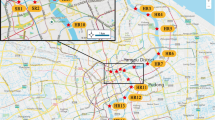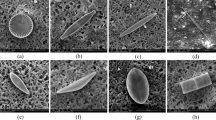Abstract
Forensic diatom test has been widely accepted as a way of providing supportive evidences in the diagnosis of drowning. The current workflow is primarily based on the observation of diatoms by forensic pathologists under a microscopy, and this process can be very time-consuming. In this paper, we demonstrate a deep learning-based approach for automatically searching diatoms in scanning electron microscopic images. Cross-validation studies were performed to evaluate the influence of magnification on performance. Moreover, various training strategies were tested to improve the performance of detection. The conclusion shows that our approach can satisfy the necessary requirements to be integrated as part of an automatic forensic diatom test.







Similar content being viewed by others
References
World Health Organization (2014) Global report on drowning: preventing a leading killer. WHO, ISBN 978-92-4-156478-6
Kaushik N et al (2017) Role of diatoms in diagnosis of death due to drowning: case studies. Medicine 7(1):59–65
Zhao J, Liu C, He S, Lu S (2013) Microwave digestion-vacuum filtration-automated scanning electron microscopy as a sensitive method for forensic diatom test. Int J Legal Med 127(2):459–446
Mitchell F (2010) The use of artificial intelligence in digital forensics: an introduction. Digit Evid Electron Signature Law Rev 7:35
Costantini S, Giovanni DG, Raffaele O (2019) Digital forensics and investigations meet artificial intelligence. Ann Math Artif Intell 86(1–3):193–229
Marianna B, Geradts Z, Eijk E (2018) Clothing identification via deep learning: forensic applications. Forensic Sci Res 3(3):219–229
Kuppa A, Grzonkowski S, Lekhac N (2018) Enabling trust in deep learning models: a digital forensics case study. Proceedings of 17th IEEE International Conference on Trust, Security and Privacy in Computing and Communications/12th IEEE International Conference on Big Data Science and Engineering, New York City, USA
Zhou Y, Zhang J, Huang J, Deng K, Zhang J, Qin Z, Wang Z, Zhang X, Tuo Y, Chen L, Chen Y, Huang P (2019) Digital whole-slide image analysis for automated diatom test in forensic cases of drowning using a convolutional neural network algorithm. Forensic Sci Int 302:109922
Uijlings JRR, van de Sande KEA, Gevers T, Smeulders AWM (2013) Selective search for object recognition. Int J Comput Vis 104(2):154–171
Gloria B et al (2017) Automated diatom classification (part A): handcrafted feature approaches. Appl Sci 7(8):753
Stefan F, Bunke H (2001) Automatic identification of diatoms using decision forests. Proceedings of 2nd International Workshop on Machine Learning and Data Mining in Pattern Recognition, Berlin, Germany
Jalba C, Wilkinson M, Roerdink J et al (2005) Automatic diatom identification using contour analysis by morphological curvature scale spaces. Mach Vis Appl 16(4):217–228
Dorado P, Pedraza A (2016) Automatic recognition of diatoms and its application to the study of water quality. Dissertation, http://hdl.handle.net/10578/11532
Viola P, Jones M (2001) Robust real-time object detection. Int J Comput Vis 4(4):34–47
Girshick R, Donahue J, Darrell T, Malik J (2014) Rich feature hierarchies for accurate object detection and semantic segmentation. Proceedings of 27th IEEE Conference on Computer Vision and Pattern Recognition, Columbus, Ohio, USA
Pedraza A, Bueno G, Deniz O et al (2018) Lights and pitfalls of convolutional neural networks for diatom identification. Opt Photon Digit Technol Imaging Appl V 10679
Redmon J, Divvala S, Girshick R et al (2016) You only look once: unified, real-time object detection. Proceedings of 29th IEEE Conference on Computer Vision and Pattern Recognition, Las Vegas, Nevada, USA
Redmon J, Farhadi A (2017) YOLO9000: better, faster, stronger. Proceedings of 30th IEEE Conference on Computer Vision and Pattern Recognition, Honolulu, Hawaii, USA
Redmon J, Farhadi A (2018) Yolov3: an incremental improvement. arXiv preprint, 1804.02767
Szegedy C, Vanhoucke V, Ioffe S et al (2016) Rethinking the inception architecture for computer vision. Proceedings of 29th IEEE Conference on Computer Vision and Pattern Recognition, Las Vegas, Nevada, USA
Lin T, Goyal P, Girshick R (2017) Focal loss for dense object detection. Proceedings of 30th IEEE Conference on Computer Vision and Pattern Recognition, Honolulu, Hawaii, USA
Buades A, Bartomeu C, Morel JM (2005) A non-local algorithm for image denoising. Proceedings of 18th IEEE Conference on Computer Vision and Pattern Recognition, San Diego, California, USA
Yann L, Bengio Y, Hinton G (2015) Deep learning. Nature 521:436–444
Werbos PJ (1994) The roots of backpropagation: from ordered derivatives to neural networks and political forecasting. John Wiley & Sons, ISBN 978-0-471-59897-8
Girshick R et al (2015) Fast R-CNN. Proceedings of the 2015 IEEE International Conference on Computer Vision, Santiago, Chile
Ren S, He K, Girshick R, Sun J (2015) Faster r-cnn: towards real-time object detection with region proposal networks. Proceedings of 29th Annual Conference on Neural Information Processing Systems, Montreal, Canada
Lin T et al (2017) Feature pyramid networks for object detection. Proceedings of 30th IEEE Conference on Computer Vision and Pattern Recognition, Honolulu, Hawaii, USA
Zhang X, Ren S, Sun J (2016) Deep residual learning for image recognition. Proceedings of 29th IEEE Conference on Computer Vision and Pattern Recognition, Las Vegas, Nevada, USA
Deng J, Dong W, Socher R et al (2009) ImageNet: a large-scale hierarchical image database. Proceedings of 22nd IEEE Conference on Computer Vision and Pattern Recognition, Miami, Florida, USA
Ioffe S, Szegedy G (2015) Batch normalization: accelerating deep network training by reducing internal covariate shift. arXiv preprint arXiv:1502.03167
Hosang J, Benenson R, Schiele B (2017) Learning non-maximum suppression. Proceedings of 30th IEEE Conference on Computer Vision and Pattern Recognition, Honolulu, Hawaii, USA
Funding
This study was financially supported by Grant-in Aids for Scientific Research from Ministry of Public Security of the People’s Republic of China (2019SSGG0403; 2020SSTG0401), and grant from the Guangzhou Municipal Science and Technology Project (2019030001; 2019030012).
Author information
Authors and Affiliations
Corresponding authors
Ethics declarations
Conflict of interest
The authors declare that they have no conflict of interest.
Ethical approval
The principles outlined in the Declaration of Helsinki were followed. The project was approved by Guangzhou Forensic Science Institute.
Informed consent
Informed consent was obtained from the legal representatives of the death cases.
Additional information
Publisher’s note
Springer Nature remains neutral with regard to jurisdictional claims in published maps and institutional affiliations.
Rights and permissions
About this article
Cite this article
Yu, W., Xue, Y., Knoops, R. et al. Automated diatom searching in the digital scanning electron microscopy images of drowning cases using the deep neural networks. Int J Legal Med 135, 497–508 (2021). https://doi.org/10.1007/s00414-020-02392-z
Received:
Accepted:
Published:
Issue Date:
DOI: https://doi.org/10.1007/s00414-020-02392-z




